Later Vedic Period Notes for UPSC IAS Exam
Later Vedic Period
The later Vedic period or post Vedic age extended roughly from 1000 B.C. to 600 B.C., during which some Vedic tribes had migrated from the ‘Sapta Sindhu’ region to the upper Ganga Valley and other adjacent areas. The history of the later Vedic period is based primarily on Vedic texts, which were compiled after the age of Rigveda.
- Use of Iron: The wide use of iron distinguishes the early Vedic phase from the later Vedic stage. This enabled the large-scale clearing of forests in the Ganga Plains. The technology of Iron smelting, however, was primitive.
- PGW Culture: The later Vedic culture is also known as Painted Grey ware culture (PGW) because of its inhabitants’ use of earthen bowls and dishes made of painted grey pottery.
- Sedentary lifestyle: The later Vedic phase marks the slow transition from a pastoral society to a sedentary agrarian society.
- Changes in social, political and economic structure: This phase witnessed several changes in their social, political, economic and religious structure.
PGW Full Form in History?
Full form of PGW in History is Painted Grey Ware culture.
Painted Grey Ware (PGW) Culture (1100-400 BCE)
- Painted Grey Ware (PGW) is a fine, smooth, and even-coloured grey pottery. PGW sites stretch over a large area, from the Himalayan foothills to the Malwa plateau and from Bahawalpur (Pakistan) to Kaushambi (Prayagraj).
- Other sites include hilly regions of Kumaon and Garhwal, Vaishali in Bihar, Lakhiyopur in Sind and Ujjain in Madhya Pradesh.
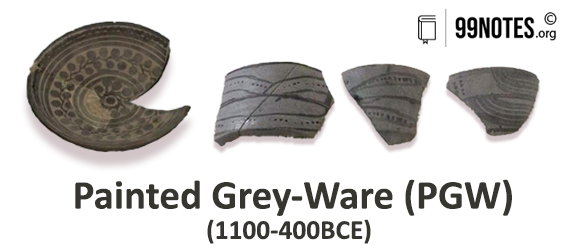
- The mature PGW phase at Jakhera has also given substantial evidence of iron implements used in agriculture like a sickle, ploughshare and hoe.
- The Painted Grey Ware (PGW) phase is followed by the Northern Black Polished Ware (NBPW), which is associated with the Mahajanapada period (600BCE onwards).

- Shelters– Structures found were wattle-and-daub and mud huts. These were constructed using unbaked bricks. For example, baked bricks were found at Hastinapura.
- Agriculture– Crops included rice, wheat and Barley. Double cropping was possibly practised. There is no significant evidence of irrigation facilities, but a few deep, circular pits outside the habitation area at Atranjikhera indicate kachcha wells. Animal husbandry was also practised.
Expansion of Vedic Culture in Later Vedic Period
The post Rig Vedic texts tell us that Aryans expanded from Punjab-Haryana over the whole of western UP covered by the Ganga-Yamuna Doab. The Vedic people succeeded in the second wave of their expansion due to the use of iron weapons and horse-drawn chariots.
- Gradually they moved towards the upper (Puru tribe) and middle portion (Panchalas) of the Doab.
- Towards the end of the later Vedic phase, around 600 BCE, the Vedic people spread from the Doab further east in Eastern UP and north Bihar.
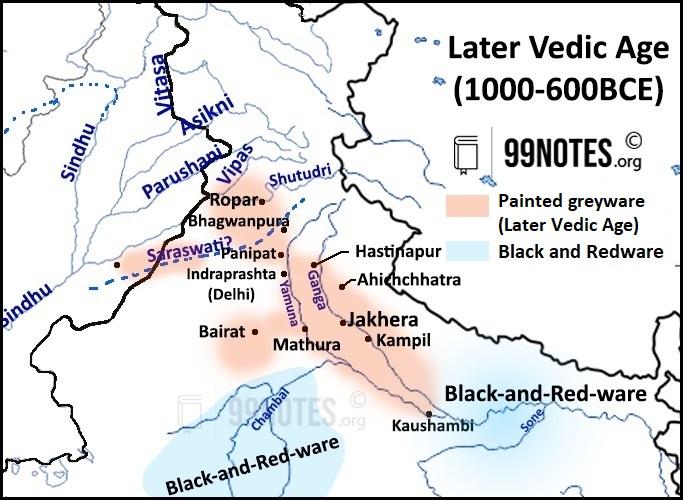
- It occurs along with other pottery types such as plain grey ware, Black and Red Ware (BRW) and black slipped ware, which were perhaps used in everyday life.
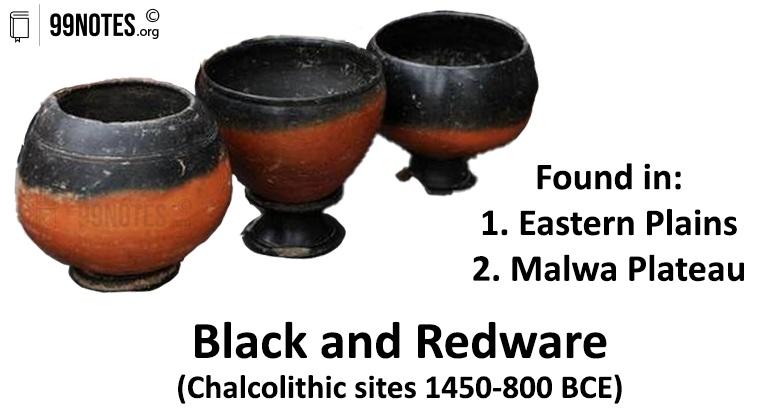
Political Organization during Later Vedic Age
- The term ‘Jana‘ was used in the sense of people or a tribe in the Rigvedic period. The members of Jana were pastoral groups roaming in search of pastures.
- However, in the later Vedic phase, the members of Jana took up agriculture and began to settle down. These agricultural settlements were called Janapadas (meaning “where the Jana set foot”).
- Rashtra was used for the first time in the Later Vedic texts. However, it was still not used in the sense of a state with well-defined territories.
| Early Vedic | Later Vedic | Maha-janapada |
| No concept of Territory | Territory not well-defined | Well- Defined Territory |
| No concept of Sovereignty | Sovereignty over tribal pastures/land – Janapada | Developed the concept of Sovereignty |
- The transition towards Mahajanpads: The coming together of tribes (such as Kurus and Panchalas) and consolidation of their respective territories led to the formation of Janpadas and later Mahajanpadas by the 6th century BCE.
- Importance of assemblies: Popular assemblies lost their importance. Vidhata disappeared completely. Women were no longer allowed to sit on the Sabha, and nobles and Brahmanas now dominated it.
- Position of King: The formation of bigger kingdoms made the king more powerful. We find traces of the election of chief or king in the later Vedic texts.
- They received voluntary presents called Bali from ordinary people.
- However, kings tried to perpetuate their right to receive gifts by making the position hereditary; the post generally went to the eldest son.
- In addition, the kings tried to increase their influence by performing rituals like Rajasuya and Ashwamedha yajna.
- Taxation: While it was voluntary in the Rigvedic period, it became a common feature in the later Vedic period. Sangrihitri was the officer made responsible for collection.
- Tribal conflicts: In place of cattle, the acquisition of territories was now a cause of dispute.
- Priest: With the rising importance of the king (Rajanya Kshatriya) dominance of Brahmins also increased since they legitimized the office of ruler by conducting rituals.
- Army: Like in the Rigvedic period, even in the later Vedic period also king didn’t possess a standing army.
Later Vedic Society
- Varna system: The position of four varnas, namely the Brahmanas, Rajanyas or Kshatriyas, Vaishyas and Shudras, became rigid. The growing cult of sacrifices enormously strengthened Brahmanas. The first three varnas were entitled to Upanayana or sacred thread, but Shudras were deprived of it. The concept of Varna had the following features:
- Status by birth
- Hierarchical ordering of varnas (Brahmanas being on top and Shudras at the base).
- Endogamy and ritual purity.
- Code of Conduct: The varna system was also attached to the concept of Dharma, i.e. Universal law; it was an attempt to establish a social law for a systematic functioning of the society.
- Institution of Gotra: The institution of gotra (literally meaning cow pen) emerged during this period. People practised gotra exogamy (marrying outside the gotra) as against tribal endogamy (marriage within the tribe). Gotra denoted descent from a common ancestor, and marriages could not occur between couples belonging to the same gotra.
- Ashramas: Ashramas, or the four stages of life, were not well established in the Vedic period. In post-Vedic texts, we hear about three ashramas- Brahmachari or student, Grihastha or householder, Vanaprastha or hermit. The fourth ashram, Sanyasin or ascetic, was not known till the time the early Upanishads were written.
- Position of women: We notice the increasing power of the father in the family. In princely families, the concept of primogeniture was getting more prominent. Women were generally given lower positions and considered inferior and subordinate to men.
Religion during Later Vedic Period
-
- Sacrifices and rituals: Sacrifices became even more elaborate in the later Vedic period and attained public and private character. The rising complexities of rituals and yajnas gave further impetus to the priestly class.
- Assimilation of cultures: Post-Vedic texts like Atharva Veda suggest the assimilation of Aryan culture with non-Aryan practices and beliefs.
- Tribal gods: The two important Rigvedic gods, Indra and Agni, lost their former importance.
-
- Age of Upanishads: It was the age when Upanisads started coming to form, and various Philosophical ideas began taking shape. This philosophical enquiry continued for at least a Millenia when the Upanishads were compiled. Following is the approximate location of various theological schools where the Upanishads were compiled.
- This eventually led to the growth of six schools of Vedic Philosophy (or the orthodox schools of Philosophy), namely: Samkhya, Vaishesika, Nyaya, Yoga, Mimamsa, and Vedanta.
- Age of Upanishads: It was the age when Upanisads started coming to form, and various Philosophical ideas began taking shape. This philosophical enquiry continued for at least a Millenia when the Upanishads were compiled. Following is the approximate location of various theological schools where the Upanishads were compiled.
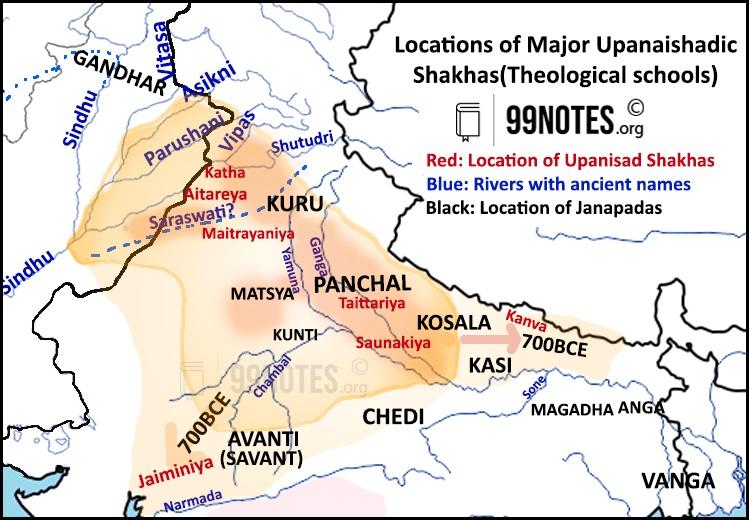
-
-
- Reaction against priestly domination: Towards the end of the Vedic period, a strong reaction against cults, rituals, and priestly domination began, especially in the land of Panchala and Videha (a tribe settled in North Bihar), where around 600 BC, the Upanishads were compiled. These philosophical texts criticized the rituals and stressed the right belief and knowledge.
-
Metallurgy, Art and Craft during Later Vedic Period
The later Vedic period also saw a rise in art and craft.
-
-
- Copper was also found at various PGW sites, one of the first metals to be used by Vedic people.
- Iron Age: The period after 1000BCE is marked by the widespread use of Iron in India. However, there are various hotly debated older discoveries from RBW areas of North India and Megalith areas of south India too.
-
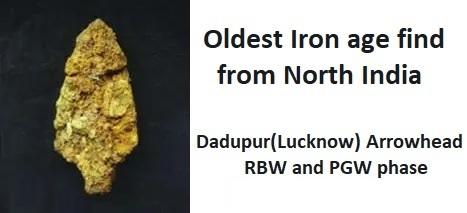
Explore additional significant articles on Ancient Indian History listed in the table below:
| Harappan Civilization | Various Aspects of Harappan Civilization |
| Stone Age | Decline of Harappan Culture |
| Vedic Period | The Mahajanapadas |
| Mauryan Empire | Gupta Empire |




![Post Mauryan Period: Shunga, Kanva Dynasties &Amp; More [Upsc Notes] | Updated November 16, 2025 Post Mauryan Period: Shunga, Kanva Dynasties & More [Upsc Notes]](https://www.99notes.in/wp-content/uploads/2023/04/post-mauryan-age-99notes-upsc-1-768x495.webp)

![Mauryan Empire (321-185 Bce): Rulers, Map, &Amp; Administration [Complete Notes For Upsc Exams] | Updated November 16, 2025 Mauryan Empire (321-185 Bce): Rulers, Map, &Amp; Administration [Complete Notes For Upsc Exams]](https://www.99notes.in/wp-content/uploads/2023/04/mauryan-empire-99notes-upsc-1-768x495.webp)
